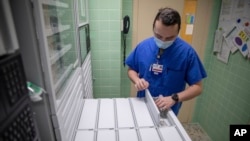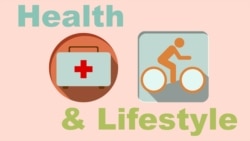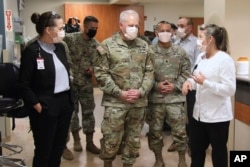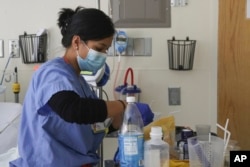The United States military deployed about 24,000 troops to help state and local governments across the country fight COVID-19. That mission has ended, at least for now. The Department of Defense is making preparations for the next possible infectious disease spread. And, officials are seeking to learn from the experiences of service members who took part in the COVID-19 mission.
The experiences can help military leaders decide on the number and kinds of troops to deploy in case another pandemic or other world crises or conflicts happen, said General Glen VanHerck. He heads the U.S. Northern Command and is responsible for defense of the homeland.
VanHerck told The Associated Press that his command is rewriting the military’s current pandemic and infectious disease plans. Officials are also planning wargame exercises to test the abilities of U.S. military medical workers.
Of the 24,000 U.S. troops deployed, nearly 6,000 medical workers were sent to assist in hospitals. About 5,000 troops helped give vaccinations.
VanHerck noted that the ways military forces were used in the pandemic “morphed” over time. He said one of the main things the military learned was that the work of small teams proved to be more valuable than mass movements of troops and facilities.
In the early days of the pandemic, the Defense Department sent hospital ships to New York City and Los Angeles. They also set up hospital operations in other states at the request of state leaders. The idea was to use the troops to treat non-COVID-19 patients so that hospitals could center on more serious pandemic cases.
But while images of the military ships were powerful, many beds went unused. Fewer patients needed non-COVID-19 care than expected and hospitals were still overloaded by the pandemic. This led to changes in how military forces were deployed. Troops were sent to hospitals to fill in for overworked employees or to work alongside them in additional treatment areas.
Lieutenant Colonel Suzanne Cobleigh led an Army team that was deployed to two hospitals in Grand Rapids, Michigan, from December to February. She spoke to Associated Press reporters about one patient the team helped at a Michigan hospital as the Omicron version of COVID-19 was quickly spreading.
The COVID-19 patient was having severe breathing difficulties, but Cobleigh said all patient beds at the hospital were full.
An Army nurse on her team knew of an open space in a temporary treatment area. The nurse quickly went into action, hurrying to get the patient wheeled to the area. During the process, the gurney struck a wall, damaging it a little.
When she saw what happened, Cobleigh praised the nurse’s drive to help her patient.
“She’s going to damage the wall on the way there because he’s going to get that bed," Cobleigh said. "(The patient) is going to get the treatment he needs. That was the mission.”
The last military medical team deployed for the pandemic finished its assignment last week at the University of Utah hospital. But officials say about 200 troops are being held on prepare-to-deploy orders through the end of May in case COVID-19 infections rise again.
I’m Bryan Lynn.
The Associated Press reported this story. Bryan Lynn adapted the report for VOA Learning English.
We want to hear from you. Write to us in the Comments section, and visit our Facebook page.
________________________________________________________________
Words in This Story
mission – n. an important job, usually involving travel to somewhere
morph – n. to change from one thing to another over time
facility – n. a place, especially in buildings, where a particular activity happens











